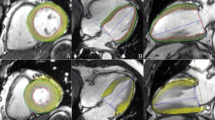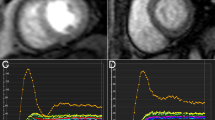Abstract
Objectives
We aimed to evaluate myocardial fibrosis using cardiac magnetic resonance (CMR) T1 mapping in type 2 diabetes mellitus (T2DM) patients and investigate the association between left ventricular (LV) subclinical myocardial dysfunction and myocardial fibrosis.
Methods
The study included 37 short-term (≤ 5 years) and 44 longer-term (> 5 years) T2DM patients and 41 healthy controls. The LV global strain parameters and T1 mapping parameters were compared between the abovementioned three groups. The association of T1 mapping parameters with diabetes duration, in addition to other risk factors, was determined using multivariate linear regression analysis. The correlation between LV strain parameters and T1 mapping parameters was evaluated using Pearson’s correlation.
Results
The peak diastolic strain rates (PDSRs) were significantly lower in longer-term T2DM patients compared to those in healthy subjects and short-term T2DM patients (p < 0.05). The longitudinal peak systolic strain rate and peak strain were significantly lower in the longer-term T2DM compared with the short-term T2DM group (p < 0.05). The extracellular volumes (ECVs) were higher in both subgroups of T2DM patients compared with control subjects (all p < 0.05). Multivariate linear regression analysis showed that diabetes duration was independently associated with ECV (β = 0.413, p < 0.001) by taking covariates into account. Pearson’s analysis showed that ECV was associated with longitudinal PDSR (r = − 0.441, p < 0.001).
Conclusion
T1 mapping could detect abnormal myocardial fibrosis early in patients with T2DM, which can cause a decline in the LV diastolic function.
Key Points
• CMR T1 mapping could detect abnormal myocardial fibrosis early in patients with T2DM.
• The diabetes duration was independently associated with ECV.
• Myocardial fibrosis can cause a decline in the LV diastolic function in T2DM patients.




Similar content being viewed by others
Abbreviations
- CMR:
-
Cardiac magnetic resonance
- ECV:
-
Extracellular volume
- LVEF:
-
Left ventricular ejection fraction
- PDSR:
-
Peak diastolic strain rate
- PS:
-
Peak strain
- PSSR:
-
Peak systolic strain rate
- T2DM:
-
Type 2 diabetes mellitus
References
Jia G, Hill MA, Sowers JR (2018) Diabetic cardiomyopathy: an update of mechanisms contributing to this clinical entity. Circ Res 122:624–638
Parim B, Sathibabu Uddandrao VV, Saravanan G (2019) Diabetic cardiomyopathy: molecular mechanisms, detrimental effects of conventional treatment, and beneficial effects of natural therapy. Heart Fail Rev 24:279–299
Dillmann WH (2019) Diabetic cardiomyopathy. Circ Res 124:1160–1162
Wong TC, Piehler KM, Kang IA et al (2014) Myocardial extracellular volume fraction quantified by cardiovascular magnetic resonance is increased in diabetes and associated with mortality and incident heart failure admission. Eur Heart J 35:657–664
Cao Y, Zeng W, Cui Y et al (2018) Increased myocardial extracellular volume assessed by cardiovascular magnetic resonance T1 mapping and its determinants in type 2 diabetes mellitus patients with normal myocardial systolic strain. Cardiovasc Diabetol 17:7. https://doi.org/10.1007/s00330-021-08056-9
Nadruz W (2015) Myocardial remodeling in hypertension. J Hum Hypertens 29:1–6. https://doi.org/10.1038/jhh.2014.36
Hayer MK, Price AM, Liu B et al (2018) Diffuse myocardial interstitial fibrosis and dysfunction in early chronic kidney disease. Am J Cardiol 121:656–660
Chamberlain JJ, Rhinehart AS, Shaefer CF Jr et al (2016) Diagnosis and management of diabetes: synopsis of the 2016 American Diabetes Association Standards of Medical Care in Diabetes. Ann Intern Med 164:542–552
Robinson AA, Chow K, Salerno M (2019) Myocardial T1 and ECV measurement: underlying concepts and technical considerations. JACC Cardiovasc Imaging 12:2332–2344
Shivu GN, Phan TT, Abozguia K et al (2010) Relationship between coronary microvascular dysfunction and cardiac energetics impairment in type 1 diabetes mellitus. Circulation 121:1209–1215
Shang Y, Zhang X, Leng W et al (2017) Assessment of diabetic cardiomyopathy by cardiovascular magnetic resonance T1 mapping: correlation with left-ventricular diastolic dysfunction and diabetic duration. J Diabetes Res 2017:9584278
Morieri ML, Perrone V, Veronesi C et al (2021) Improving statin treatment strategies to reduce LDL-cholesterol: factors associated with targets’ attainment in subjects with and without type 2 diabetes. Cardiovasc Diabetol 20:144. https://doi.org/10.1186/s12933-021-01338-y
Mandavia CH, Aroor AR, Demarco VG, Sowers JR (2013) Molecular and metabolic mechanisms of cardiac dysfunction in diabetes. Life Sci 92:601–608
Loganathan R, Bilgen M, Al-Hafez B et al (2006) Characterization of alterations in diabetic myocardial tissue using high resolution MRI. Int J Cardiovasc Imaging 22:81–90
Ide S, Riesenkampff E, Chiasson DA et al (2017) Histological validation of cardiovascular magnetic resonance T1 mapping markers of myocardial fibrosis in paediatric heart transplant recipients. J Cardiovasc Magn Reson 19:10. https://doi.org/10.1186/s12968-017-0326-x
Fontana M, White SK, Banypersad SM et al (2012) Comparison of T1 mapping techniques for ECV quantification. Histological validation and reproducibility of ShMOLLI versus multibreath-hold T1 quantification equilibrium contrast CMR. J Cardiovasc Magn Reson 14:88. https://doi.org/10.1186/1532-429X-14-88
Lejeune S, Roy C, Slimani A et al (2021) Diabetic phenotype and prognosis of patients with heart failure and preserved ejection fraction in a real life cohort. Cardiovasc Diabetol 20:48. https://doi.org/10.1186/s12933-021-01242-5
Lam CS (2015) Diabetic cardiomyopathy: an expression of stage B heart failure with preserved ejection fraction. Diab Vasc Dis Res 12:234–238
Ernande L, Rietzschel ER, Bergerot C et al (2010) Impaired myocardial radial function in asymptomatic patients with type 2 diabetes mellitus: a speckle-tracking imaging study. J Am Soc Echocardiogr 23:1266–1272
Ernande L, Bergerot C, Girerd N et al (2014) Longitudinal myocardial strain alteration is associated with left ventricular remodeling in asymptomatic patients with type 2 diabetes mellitus. J Am Soc Echocardiogr 27:479–488
Ng AC, Delgado V, Bertini M et al (2009) Findings from left ventricular strain and strain rate imaging in asymptomatic patients with type 2 diabetes mellitus. Am J Cardiol 104:1398–1401
Claus P, Omar AMS, Pedrizzetti G et al (2015) Tissue tracking technology for assessing cardiac mechanics: principles, normal values, and clinical applications. JACC Cardiovasc Imaging 8:1444–1460
Jellis C, Wright J, Kennedy D et al (2011) Association of imaging markers of myocardial fibrosis with metabolic and functional disturbances in early diabetic cardiomyopathy. Circ Cardiovasc Imaging 4:693–702
Laohabut I, Songsangjinda T, Kaolawanich Y et al (2021) Myocardial extracellular volume fraction and T1 mapping by cardiac magnetic resonance compared between patients with and without type 2 diabetes, and the effect of ECV and T2D on cardiovascular outcomes. Front Cardiovasc Med 8:771363
Ng AC, Auger D, Delgado V et al (2012) Association between diffuse myocardial fibrosis by cardiac magnetic resonance contrast-enhanced T1 mapping and subclinical myocardial dysfunction in diabetic patients: a pilot study. Circ Cardiovasc Imaging 5:51–59
Casis O, Gallego M, Iriarte M et al (2000) Effects of diabetic cardiomyopathy on regional electrophysiologic characteristics of rat ventricle. Diabetologia 43:101–109
Kalam K, Otahal P, Marwick TH (2014) Prognostic implications of global LV dysfunction: a systematic review and meta-analysis of global longitudinal strain and ejection fraction. Heart 100:1673–1680
Omar AM, Vallabhajosyula S, Sengupta PP (2015) Left ventricular twist and torsion: research observations and clinical applications. Circ Cardiovasc Imaging 8:e003029
Algranati D, Kassab GS, Lanir Y (2011) Why is the subendocardium more vulnerable to ischemia? A new paradigm. Am J Physiol Heart Circ Physiol 300:H1090–H1100
Funding
This work was supported by the National Natural Science Foundation of China (82102022, 82120108015, 81971586, 81771887, 81471722), 1·3·5 project for disciplines of excellence, West China Hospital, Sichuan University (ZYGD18013).
Author information
Authors and Affiliations
Corresponding author
Ethics declarations
Guarantor
The scientific guarantor of this publication is Dr. Zhi-Gang Yang.
Conflict of interest
The authors of this manuscript declare no relationships with any companies whose products or services may be related to the subject matter of the article.
Statistics and biometry
One of the authors (Yue Gao) has significant statistical expertise, and no complex statistical methods were necessary for this paper.
Informed consent
Written informed consent was obtained from all subjects in this study.
Ethics approval
Institutional Review Board approval was obtained.
Methodology
• prospective
• diagnostic or prognostic study
• performed at one institution
Additional information
Publisher’s note
Springer Nature remains neutral with regard to jurisdictional claims in published maps and institutional affiliations.
Rights and permissions
About this article
Cite this article
Liu, X., Gao, Y., Guo, YK. et al. Cardiac magnetic resonance T1 mapping for evaluating myocardial fibrosis in patients with type 2 diabetes mellitus: correlation with left ventricular longitudinal diastolic dysfunction. Eur Radiol 32, 7647–7656 (2022). https://doi.org/10.1007/s00330-022-08800-9
Received:
Revised:
Accepted:
Published:
Issue Date:
DOI: https://doi.org/10.1007/s00330-022-08800-9




